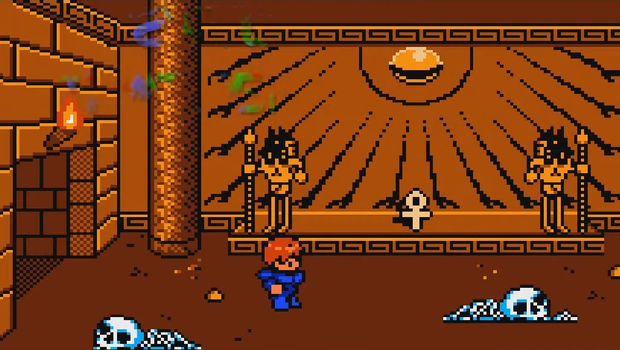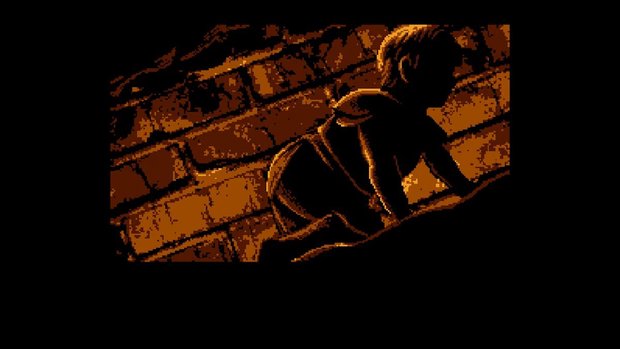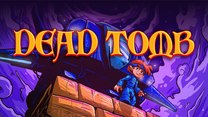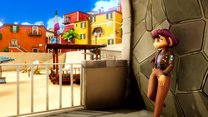Dead Tomb review

- 0 Comments
Its ancient pyramid setting is a treasure, but a verb-style console interface is a concept perhaps best left buried
Many of us long-time adventurers have spent more than our fair share of time knee-deep in SCUMM – the acronym in this case standing for the Lucasfilm Games engine that catapulted the genre away from the text-parser input system towards a point-and-click interface through a selection of specific verb options. SCUMM and its ilk have themselves long been cast aside for more intuitive, user-friendly control schemes, though they do occasionally resurface in games that aim to take us back to our roots. CollectorVision’s Dead Tomb is one such throwback, a spelunking console-exclusive adventure that revives the tried-and-tested control scheme but unwittingly reminds us that a nostalgic interface alone does not a satisfying adventure make.
The narrative setup quickly reveals itself to be a bit of a non-sequitur: You are an explorer, a young man sent from the future through space and time to research the last ice age. However, this plot is soon discarded as your ship suffers a mechanical malfunction along the way, and you’re forced to make a pit stop in Ancient Egypt, atop a pyramid, to fix it. (This is the game’s actual setting.) Then, just as you think you’re wrapping things up, the local pharaoh’s soldiers find you and escort you at spearpoint to the pyramid’s dungeon. Your objective is to recover the diamond that powers your ship (still parked on top of the pyramid) and escape in one piece. As for the ice age exploration, well, that particular plot point is never revisited.
Keeping with its retro control scheme, Dead Tomb manages to successfully ape a very 8-bit presentation. (Not that this should come as a surprise, given that it is published by 8-Bit Legit and even released – in limited quantities – on a custom NES cart.) As a result, the graphics certainly get the job done but don’t feature any particularly noteworthy flourishes to jazz things up. (Barring, if one were to feel charitable, some full-size splash screens that pop up to mark our hero’s progress between areas of the pyramid, such as when he’s crawling through narrow tunnels or preparing to embark down dark passageways.)

The ancient Egyptian aesthetic is generally well-represented in the visual design, though this naturally means lots of yellows and browns – sand and tomb colors – with darker blues and blacks in the deepest dungeons. This serves to make the occasional splash of color – like when you come upon a room with a pool of clear blue water that feeds lush green vegetation – welcome by comparison. Otherwise, everything you’d expect is present and accounted for – plenty of ankhs, hieroglyphs, ouroboroses, etc., along with the occasional statue or two. It’s a shame, then, that the aspects of the world you interact with tend to be of the more banal variety. For example, our hero is more interested in the usefulness of a rope attached to a wall rather than the ancient texts scrawled on said wall.
It is worth pointing out that the gameplay area only occupies a limited portion of your screen, essentially half, as it has to make way for the twelve-verb interface used to interact with the world, centered in the lower part of the screen. With the play area thus scaled down, it is flanked by two bars of unused space, which can instead be set to display a small selection of optional borders.

While the graphics shouldn’t disappoint anyone going in with the right expectations, the small selection of quickly repeating chiptune music tracks is a good deal closer to what one might call bare bones. Fortunately, as the game only takes around an hour or two to complete, the audio repetition isn’t so egregious as to become notably bothersome, just lacking much in the way of luster. The designers’ adherence to the 8-bit dogma similarly prohibits any modern amenities like voice acting or even a narrator occasionally chiming in.
So it looks and sounds unapologetically like a game from the late 80s, but is Dead Tomb any fun? While I found the prospect of exploring an ancient Egyptian pyramid initially exciting, and the chance to experience it via a SCUMM-style interface enticing, the final product is far less glamorous an experience. The pyramid is divided into individual rooms that must be traversed, each one the size of one in-game screen. This means the rooms are all rather on the small side, with only a couple points of interest (maybe two or three on average). As we move our nameless hero around the screen (directly controlling him via the Switch’s D-pad for me – being a console exclusive, there is thankfully no simulated awkward pointing and clicking), on-screen indicators pop up to indicate interactive hotspots. A press of a button will then call up the verb interface, consisting of choices such as “Look,” “Move,” “Take” and the like. This is when the guessing game of how to interact with the puzzles begins.
There are times when it seems fairly obvious exactly what command will interact with your surroundings to achieve your desired goal. For example, getting out of your cell – the very first room the game places you into – requires noticing that one of only a couple of interactive hotspots in the room is a drift of sand that has piled up at the base of the brick wall. “Look”ing at the sand will inform you that there appears to be an opening behind it. Now, there’s not a whole lot of things I’m willing to attempt to do with sand, and since this particular pile seemed to be sealing off my egress from captivity, “Move”ing it seemed like the very obvious (and correct) solution.
While other puzzles may be equally transparent, there are also those that reduced me to trial and error, standing at each hotspot and selecting all possible verb choices since I couldn’t work out what leap of logic the game expected me to make. At one point, I needed to find a way to interact with an altar-like stone block that seemed to be sealing off my path forward. The skeletal corpse on the ground nearby suggested to me that interacting with the altar incorrectly could perhaps have fatal consequences. (Indeed, in the spirit of early Lucasfilm Games adventures, there are a number of achievable death scenarios that will end your adventure prematurely – or, rather, send you back to the start of the current room.) After wracking my brain over how to make an offering using the verbs available to me – or even determining if I had an object worth offering up in the first place and deciding I didn’t – I spent an equal amount of time backtracking and searching for the missed item, or perhaps a switch that would move the altar since offerings were in short supply. Nothing seemed to work, and it was only through clumsily exhausting all possible command options that I accidentally stumbled upon the right way to proceed.

Suffice it to say, brute-forcing puzzles like this isn’t the most satisfying approach. Such instances aren’t in the overwhelming majority – most of the game’s puzzles don’t go deep enough to require anything even adjacent to moon logic to solve – but in such a short game, any instance of feeling unfairly stuck, regardless for how long, feels noticeable.
However, let’s say that rote experimentation doesn’t bother you and you’re satisfied with the verb interface being more obtuse than most of the actual puzzles themselves. There are still a number of smaller, more niggling ways in which Dead Tomb challenges the idea that your time is being used wisely. While each individual room is explored via the in-game display, navigating through the pyramid is accomplished mostly by way of a separate map screen. Every time you exit a room, the game automatically brings up a map in which you move a blip through a cross-section of the pyramid, represented by simple connected squares that are gradually filled in as you progress. This system in itself is fine, but it does tend to slow down prolonged instances of traveling from point A to far-off point B. You see, the map is fragmented into many different layered sections with only a few rooms each, and allows access to only one adjoining room at a time, rather than letting you move your blip around the pyramid at will. This means that whenever you wish to backtrack, each room must be manually traversed again, then exited in the opposite direction before being sent back to the map screen to repeat the process. Needless to say, this back-and-forth between the map screen and previously cleared rooms quickly turns tedious.
Using inventory items correctly is another common gameplay aspect that didn’t work as I thought it would. You’ll frequently pick up and carry objects with you, and there’s even an inventory screen on which you can examine them in more detail. But although the verb interface provides a “Use” option on the actual inventory screen, it turns out that simply possessing the required item in the necessary location will add an extra option to choose from in the command interface, which would then automatically make use of the item in question.
The layout of the pyramid itself eschews rhyme or reason, as doorways and passages frequently and perplexingly connect to far-flung sections of the pyramid. Another odd choice is the omission of a save system – something I found out the hard way when I took a break about halfway through and was forced to restart the game upon my return. Instead, a ten-digit alphanumeric password system is included, though not only is writing down such a password – never mind actually inputting it to kick off your next game session – so clunky that most people probably won’t bother with it (I didn’t), but the passwords themselves must first be found in the environment, transcribed on a handful of items. Perhaps this was a concession to fit the constraints of the NES release, but, like our hero, it feels like a misplaced anachronism.
Final Verdict
Much like the artifacts housed in its eponymous burial sites, Dead Tomb looks and plays like a relic from an age long past, and though there are a lot of us who fondly experience games meant as nostalgia-laced love letters, this one is simply too weighed down by the dust and must of the ages. While there’s nothing wrong with the idea of bringing back the verb-based command interface for a tomb-raiding adventure through an ancient pyramid, the unintuitive way in which puzzles make use of it here feels stilted rather than inspired, and pointlessly drawn-out navigation sequences and a useless password system are the two final nails in its sarcophagus. I appreciate the attempt to revisit the good old days, and there’s definitely some fun to be had with the better challenges included here, but especially with gamepad limitations that don’t allow for point-and-click controls, the remains of SCUMM-style adventuring deserve a better vehicle and should perhaps have been left undisturbed rather than exhumed exclusively for consoles this time around.
Hot take
CollectorVision’s dedication to recreating an authentic nostalgic experience is clearly evident on every screen, but whenever Dead Tomb goes out of its way to make the experience as cumbersome as possible, this jaunt to Ancient Egypt will leave you parched for a more robust experience.
Pros
- Exploring a pyramid in Ancient Egypt makes for a pitch-perfect setting for some quality adventuring
- Bringing back the verb-based control mechanic of classic adventures still holds nostalgic merit
Cons
- Puzzles range from simple to unintuitive, with an interface that is nothing if not restrictive
- Despite a map, backtracking requires laborious manual traversal
- Cumbersome ten-digit alphanumeric password system
Pascal played Dead Tomb on Nintendo Switch using a review code provided by the game's publisher.











0 Comments
Want to join the discussion? Leave a comment as guest, sign in or register.
Leave a comment